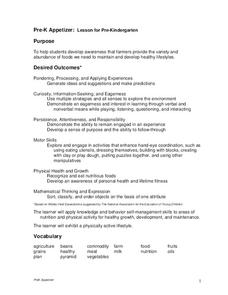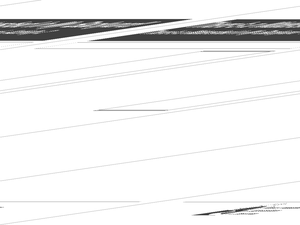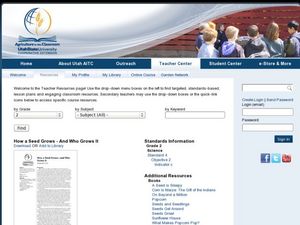Curated OER
What's In Your Grocery Bag?
Young scholars explore the global implications of consumer decisions when purchasing groceries. They examine labels of food products and discuss the wording on the labels. They calculate food miles of how far each ingredient in foods...
Curated OER
What is in Soil?
Fourth graders identify and examine the components that make up soil. Individually, they use a magnifying glass to identify the organic and inorganic material in their soil sample. To end the lesson, they record the differences in the...
National First Ladies' Library
The Civil War Revisited
Students move beyond the generals and battles approach to the Civil War and explore, instead, the issues, ideals, and outcomes of the great conflict that left a president dead, a region destitute, and a nation in shambles.
Curated OER
Imaginative Minds
Eighth graders study the lives and creations of several significant inventors as well as designing their own invention and submitting it to a mock patent process. They determine the importance of notable inventions and their impact on...
Curated OER
Bribery And Corruption
In this language arts worksheet, pairs of students examine, discuss, and complete a variety of activities associated with bribery and corruption. The "conversation starters" are particularly interesting in this worksheet, and should make...
Curated OER
Vocabulary Worksheets - Reading: The Food Pyramid
In this vocabulary activity, students read a passage about the food pyramid and then answer 8 multiple choice comprehension questions.
Curated OER
Reading: The Food Pyramid
For this reading comprehension worksheet, students read a one page text about the food pyramid. Students then complete 8 sentences with the correct words from 2 choices.
Curated OER
Civilization Pie
Students define civilization as it was in ancient times. In this world history lesson, students work in small groups to write a recipe that has all the combined ingredients of early civilized societies and share their results with...
Curated OER
Beyond Chopsticks and Rice
Students explore the stereotypical American images of China. In this English and World History lesson, students read a novel to become familiar with China and its people. Students research various events in China's history and report...
Curated OER
Pre-K Appetizer
Students understand there are healthy and not healthy food choices. In this food pyramid lesson, students learn to make healthy choices by playing a traffic light game. Students recognize raw foods from the farm may not be ready for...
Curated OER
Exploring the USA and the World with Cartograms
Students investigate cartograms in order to explore the different countries on Earth. In this world geography lesson, students use the Internet to analyze data on different cartograms. Students compare data, such as population density,...
Curated OER
Eat Smart, Play Hard
Students discover why breakfast is important. In this nutrition lesson plan, students read a "Power Up With Breakfast" worksheet and discuss the importance of breakfast. Students draw pictures of fruit they would want in their breakfast...
Curated OER
What's a Swamp Good For?
Students identify the function and value of wetlands. In this lesson on appreciating wetlands, students explain how different household items can represent different aspects of the wetlands.
Curated OER
Veggie Quesadilla Recipe: Possessive Nouns
Students identify nouns and pair them with a possessive noun. For this possessive noun lesson, students read a recipe and identify the nouns. Then, students pair each noun with a possessive noun and use them in a sentence.
Curated OER
Archaeological Study
Students analyze the difference between archaeology and anthropology while studying the evolution of different products. In this archaeology and anthropology lesson plan, students trace the progression of a certain tool or product and...
Curated OER
There's a Watershed in my Backyard!
Young scholars explain what the term watershed is by creating a model. In this science, geography lesson, students demonstrate how the water moves in a watershed. Additionally, young scholars learn about point source and nonpoint source...
Curated OER
Exploration Watershed
Students discuss what a watershed is, and locate watersheds on a map. In this watershed lesson, students use the information they have been introduced to and create a color coded watershed map of their own.
Curated OER
Be a Watershed - Create a Living River
Students investigate water ways by conducting an experiment with classmates. In this natural resources lesson, students define a watershed and identify where large ones are located within the United States. Students utilize...
Curated OER
Piece Like a River
Students investigate water formations by creating a puzzle. In this water properties lesson, students create a giant river puzzle by drawing on large butcher paper as a class, then dividing the image up into many pieces. ...
Curated OER
Weight Control
Students study the importance of a healthy diet. In this weight control lesson students divide into groups and develop a healthy lunch menu.
Curated OER
How a Seed Grows: And Who Grows It
Second graders explore botany by viewing video clips in class. In this seed growth lesson, 2nd graders identify the types of seeds that grow specific plants and what the optimal conditions are for growing seeds. Students view a video...
Curated OER
Barter Day
Fifth graders research bartering. In this bartering lesson, 5th graders investigate bartering as a way to trade for goods and services. Students experience bartering first hand while playing a game.
Curated OER
Eat Your Plants
Students explore fruits and vegetables. In this fruits and vegetables lesson plan, students work in small groups investigating plant parts. Students discover that fruits and vegetables originate from different parts of plants.
Curated OER
Where's the Grass
Students participate in a grassland game. In this grassland lesson, students simulate the impact of grazing animals and invasive weeds on grasslands.

























